Garden Plants | 100 Hosta Species: The ShadeTolerant King with a Variety of Colors
Hosta is a highly visible perennial plant these days, but its popularity was short-lived. Twenty years ago, hosta wasn't even in the top 20 most frequently used perennial flowers, a major reason being its high price. Before the advent of tissue culture, hosta could only propagate by root division, which was too slow. Some promising new varieties often cost two to three hundred dollars per bud, limited to enthusiast circles. However, new varieties now, unless patented, are typically tissue-cultured by Dutch companies within three years, quickly becoming street vendors and gaining widespread popularity. However, new technology is often a double-edged sword. While it's good news for consumers, it's a dark cloud for breeders. Traditional hosta producers have either switched to other shade-loving perennials or significantly reduced their plantings, as production costs simply can't compete with those of Dutch companies.

Hosta's natural distribution is concentrated in China, Japan, and South Korea. While the genus Hosta is divided into approximately 23 species in botany, it is divided into over 40 species in horticulture, with many variants. While sufficient research evidence is lacking to definitively define hosta species, the details remain debatable. In the wild, hosta exhibits numerous transitional forms and natural variants between species, and the same species can exhibit diverse traits depending on the climates of the north and south. Even within the same species, significant differences in external traits can lead to different values in hybridization. Furthermore, within the genus Hosta, there is virtually no interspecific isolation, allowing for easy hybridization (although some parent species may have poor reproductive capacity). Therefore, botanical parent species classification is less important for horticultural hybridization.
The number of horticultural hosta species is enormous, conservatively estimated to be in the tens of thousands. Hosta nurseries typically classify species based on their characteristics, and the following list uses a selection of common classification labels. This approach is not systematic and may include omissions, but it is practical.
Giant Hosta
Giant hostas often have genes from H. sieboldiana, H. nigrescens, and H. montana, all native to Japan and widely used in hybridization.
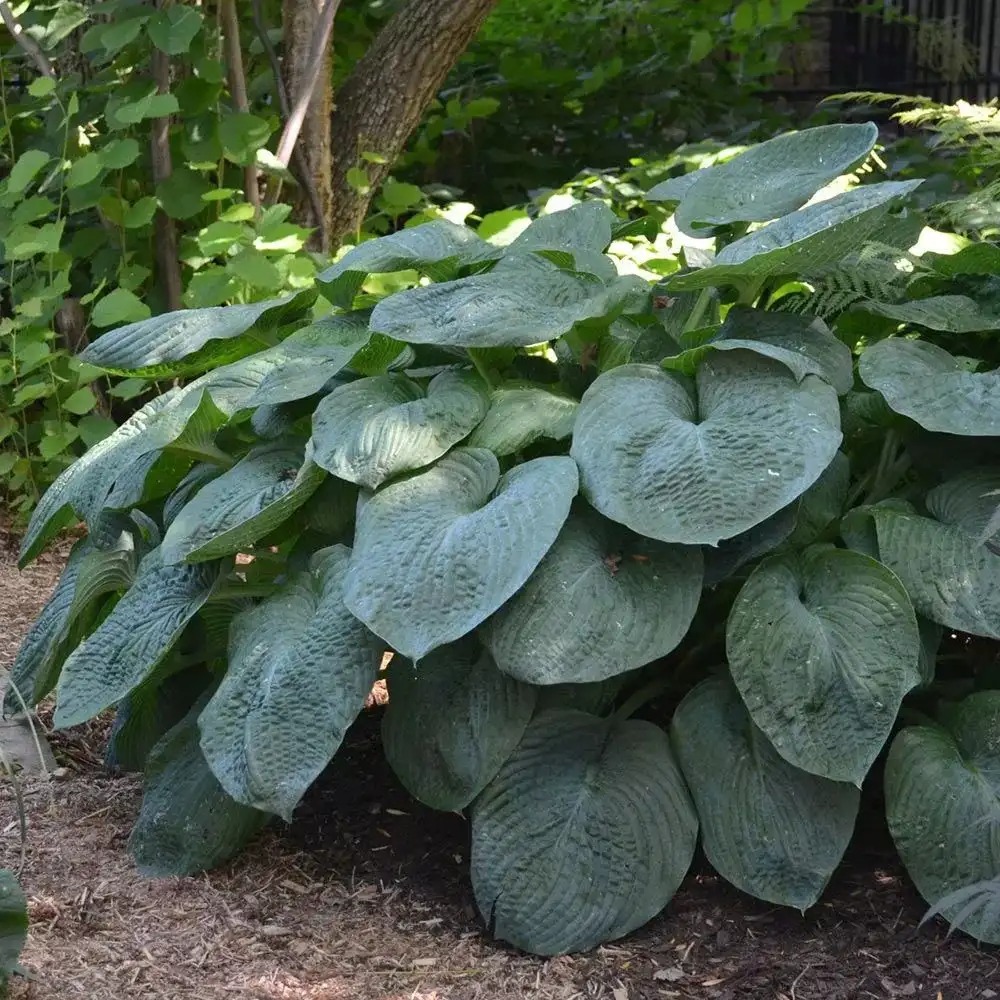
Hosta sieboldiana 'Elegans'
The original species of 'H. sieboldiana' (H. sieboldiana) is not commonly found in the market. Currently cultivated in Europe and the United States is an early German hybrid of H. sieboldia, 'Elegans'. This variety is bluer than the original H. sieboldia, with more wrinkled leaves and denser flowers. This variety grows tall, with thick, bluish-green leaves in spring. Slugs dislike it, but it is not drought-tolerant. Most commercially available blue hosta varieties contain this gene.

Empress Wu
'Wu Zetian' is known as the largest hosta variety, but the actual measured>
Earth Angel
The 2009 Hosta of the Year, with very thick leaves
Giant cultivars of the round-leaved Hosta hybrid family include 'Empress Wu,' 'Gentle Giant,' 'Big John,' and 'Blue Giant.' These are generally blue, but there are also variegated varieties, such as 'Earth Angel,' a variant of 'Blue Giant,' which was the first variegated variety of this type.

Hosta nigrescens Black jade
Another type of giant hosta is a hybrid of black hosta. 'Black Hosta' is a tall, stocky variety that's quite different from the more common ground cover hosta. Its leaves are dark green and thick.

2015 Hosta 'Victory'
The black hosta gene is very obvious, the plant is tall, and it is a rare variegated leaf species among giant hostas.
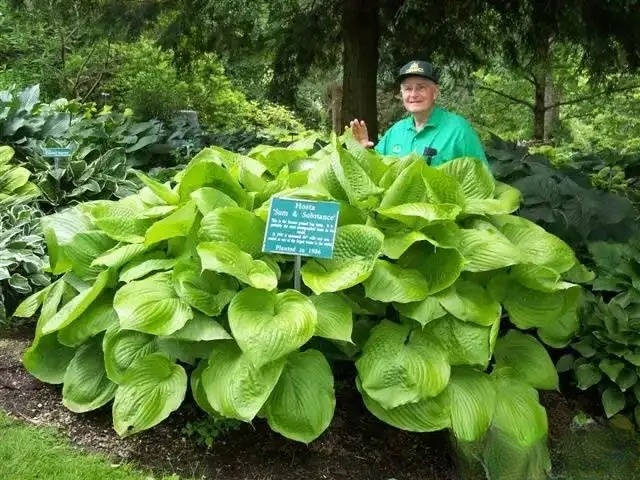
2009 Hosta 'Sum and Substance' (Big Mac)
The best-selling giant hosta in North America, a rare golden leaf variety.
Although its parents are unknown, it is generally believed to have genes from 'Black Hosta'.
The mature size of a hosta plant is greatly affected by its growing environment. If surrounded by large trees or planted in a container, the hosta's root system won't have enough room to expand, and giant hostas won't grow very large. Therefore, if you don't have enough space, there's no difference between giant hostas, large hostas, and medium hostas. Additionally, giant hostas tend to be smaller in warm, humid climates than in colder ones.
Mini Hosta
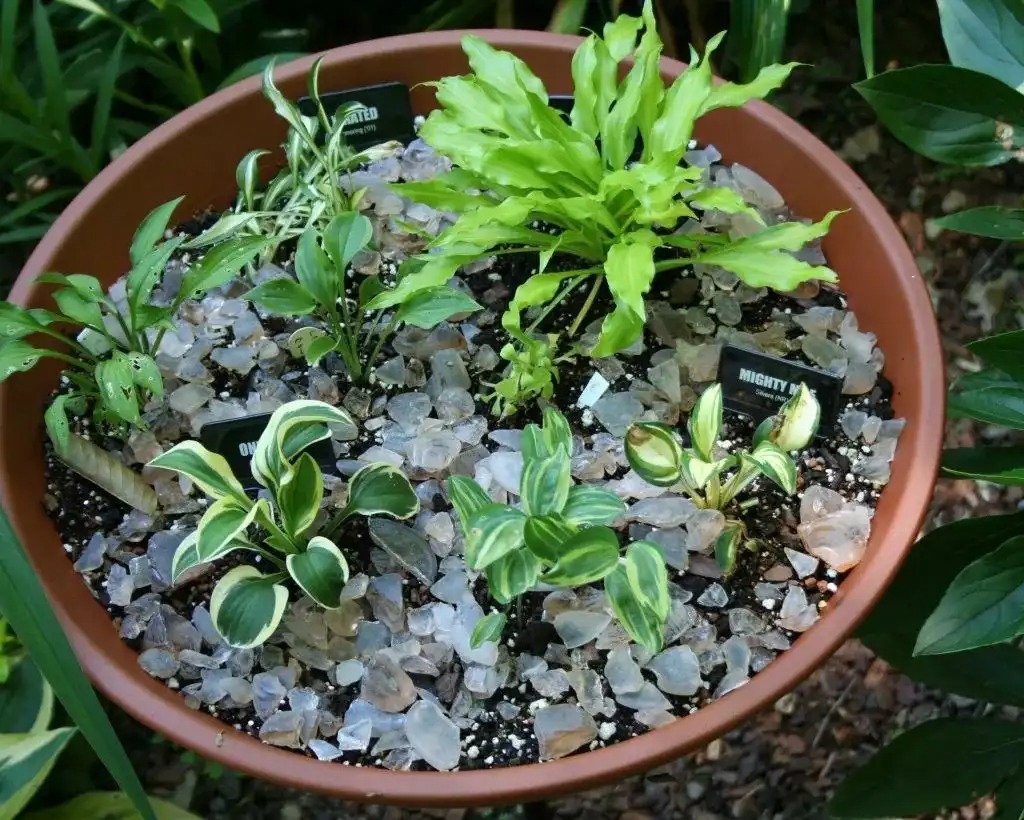
Before World War II, Japanese gardeners specialized in collecting hybrid mini hostas, originally planning to exhibit them at the Chelsea Flower Show in the UK. However, World War II broke out two weeks before shipment to the UK, and the exhibition was canceled. In recent years, mini hostas have become extremely popular. The emergence of new 'Mouse Ear' varieties has significantly improved their horticultural performance compared to previous mini hostas. Furthermore, with current housing prices, most people are limited to growing flowers on their balconies. Therefore, mini hostas are expected to continue to gain popularity in the market .
Although mini hostas all look similar, they come from very different sources.
Origin 1: Hybrid offspring of a miniature hosta. Many early miniature hostas were self-pollinated or simply hybridized with the Korean 'Lovely Hosta' (Hosta venusta). 'Venusta' means "lovely, attractive" in Latin. This species grows only 15 cm tall. It served as a parent for numerous miniature hosta varieties, such as Tiny Tears and Thumb Nails. These miniature hostas have thin leaves that are not sun-resistant and easily gnawed by slugs.
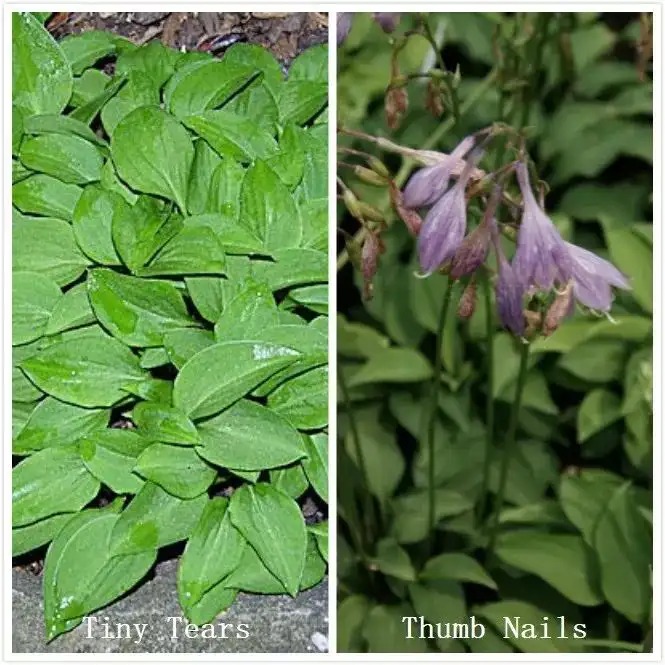
Source 2: A variant of the common hosta. The recently popular miniature hosta 'Blue Mouse Ears' is a tissue culture variant of the medium-sized hosta 'Blue Cadet'. It was discovered in Maryland, USA, and was selected as Hosta of the Year by the American Hosta Growers Association in 2008.

This variety is rare. Most blue hosta varieties share genes from the round-leaved hosta, but the round-leaved hosta mentioned above grows quite large, and pure hybridization often requires decades of repeated selection to miniaturize it. Furthermore, the thick leaves of the 'Blue Mouse Ear' are more resistant to slugs. Hosta leaves are slightly sweet, making them a perfect slug. These nasty creatures inhabit dark, damp areas and are not only hosta killers, but also a predator of many shade-loving plants, such as hydrangeas and hydrangeas. They typically emerge at night, consume leaves, and then retreat to a place out of direct sunlight.
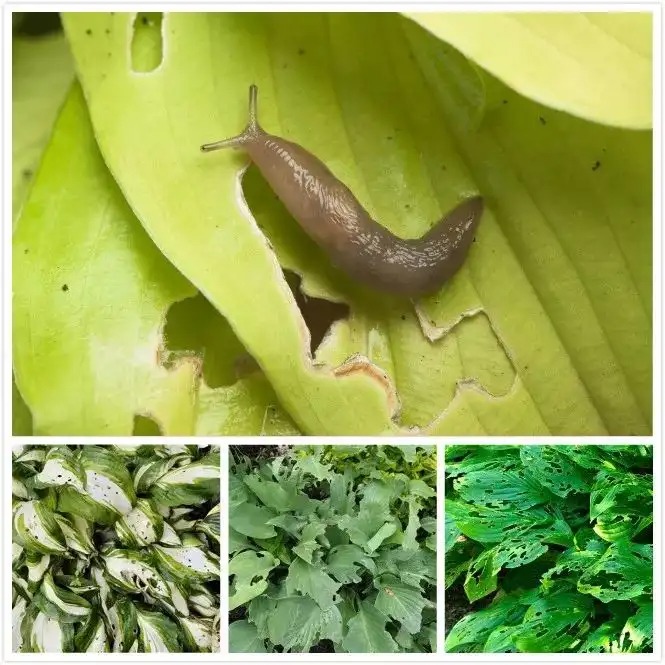
Hosta species with thin leaves are generally more susceptible to slugs, while hostas with thicker, wrinkled leaves are less susceptible to slugs (though not completely immune). This is particularly important for miniature hostas. While large species can be bitten off without much of a problem, miniature hostas can be devoured in just a few bites.
Source three: Mini Hosta variants. For example, the classic cultivar 'Blue Mouse Ear' has spawned numerous variants, some naturally occurring and others cultivated through tissue culture. These variants, in turn, continue to mutate, giving rise to even more varieties. Currently, there are nearly 40 mini Hosta varieties derived from 'Blue Mouse Ear,' most of which contain the word "mouse" in their names.
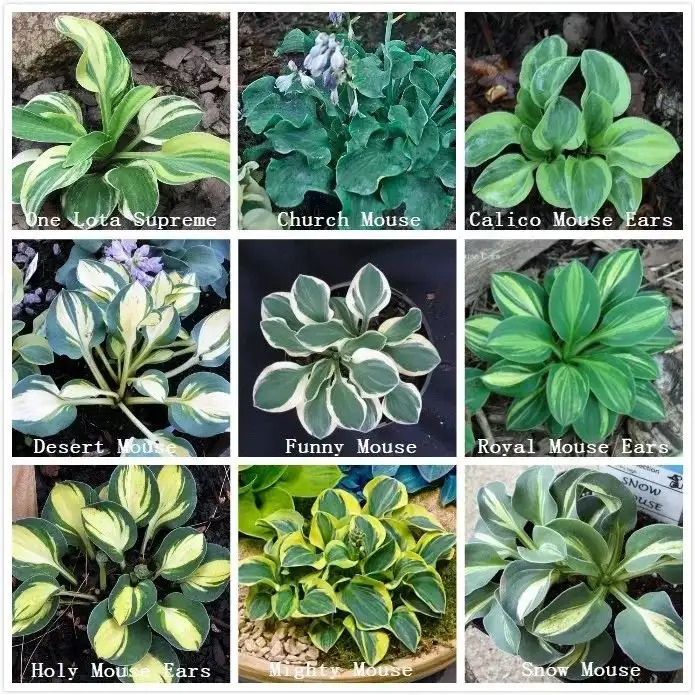
Overseas, these new varieties are defined as Essentially Derived Varieties (EDVs), which translates to "substantially derived varieties" in Chinese. If the discoverer of the Blue Mouse-Ear variety had registered a new variety, she would have subsequently acquired a share of the commercial rights to all of these variants. Unfortunately, the discoverer of the Blue Mouse-Ear variety failed to recognize its commercial potential and failed to register it.
Source 4: It is derived from hybridization using the Blue Mouse Ear as a parent. Most mutants of the Blue Mouse Ear are infertile, so they cannot become parents in hybridization. However, the Blue Mouse Ear itself is fertile.
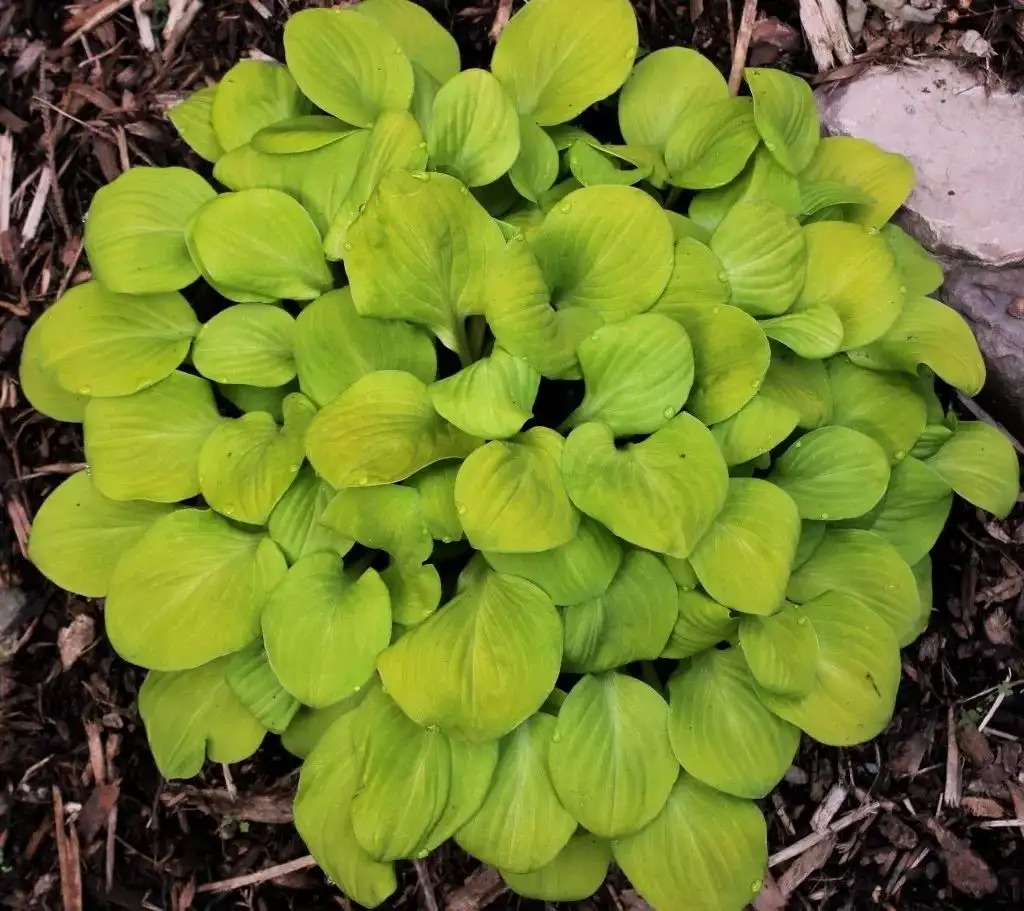
'Sun Mouse'
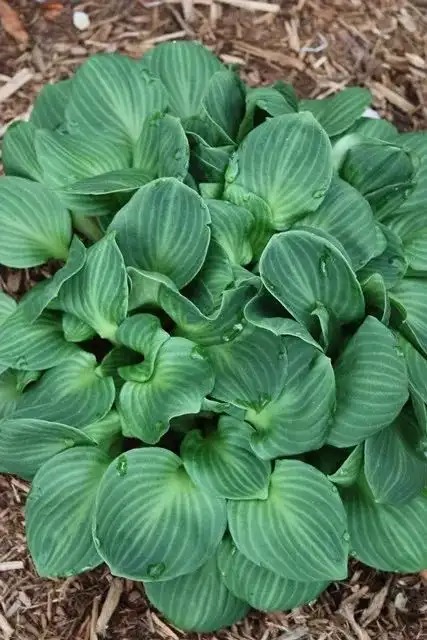
You have many lines 'You're so vein
These two varieties were created by Tony Avent of Plant Delights Nursery in the United States after four or five generations of selective breeding. They possess the blue mouse-ear gene, but are not as miniature. Some people believe that a sudden mutation is less effective than decades of painstaking hybridization, but they fail to realize that these mutant varieties also evolved through years of hybridization.
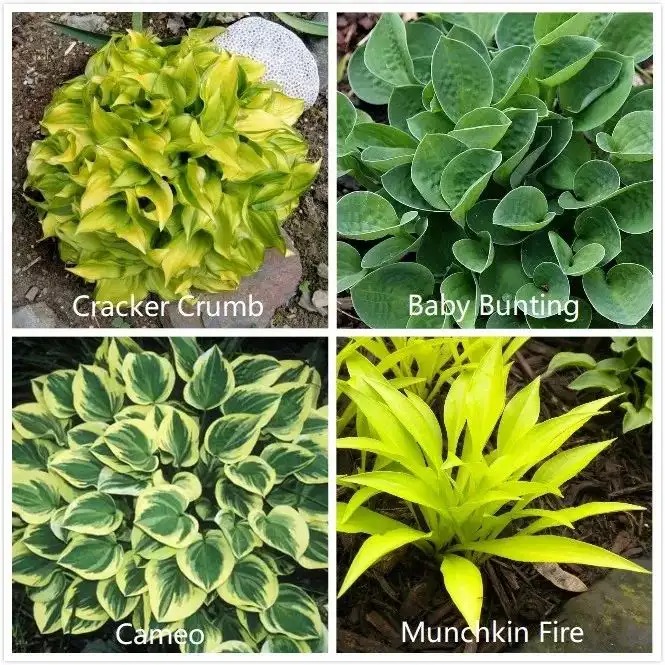
In addition to the mouse ear series and its hybrid offspring
The mini hostas above are also very popular varieties abroad.
Aromatic Hosta
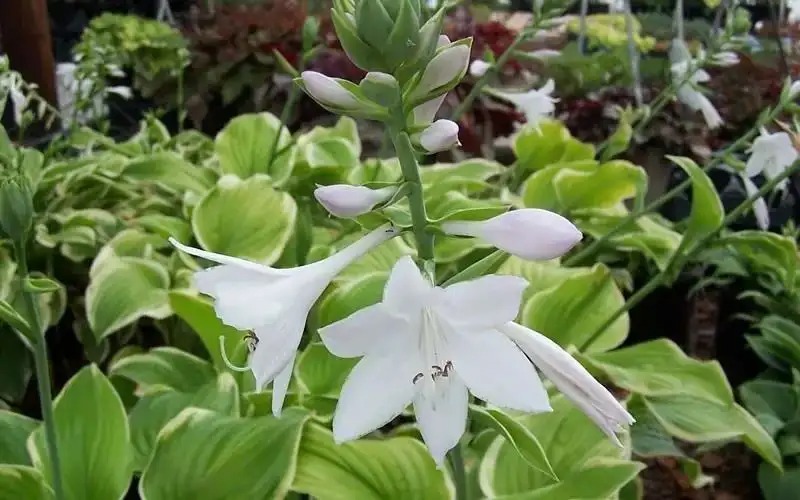
Hosta plantaginea
The only original species with fragrance. To avoid confusion, the following text uses "white calyx hosta" to refer to
Traditionally, hostas are primarily cultivated for their foliage, with little expectation for their flowers. But wouldn't it be even more perfect if a hosta had beautiful leaves, large, fragrant flowers? The British television program "Gardening World" once interviewed a hosta collector who said his favorite variety is 'Fragrant Boquet,' a classic variety with beautiful leaves and fragrant flowers.

'Fragrant Bouquet' was the Hosta of the Year in 1998. Its mutant, 'Guacamole', was named Hosta of the Year in 2002. 'Guacamole' in turn mutated into 'Stained Glass', which was named Hosta of the Year in 2006. 'Stained Glass' also has a tetraploid mutant, 'Cathedral Window', with thicker leaves. It's also very popular and might even win again. To put it bluntly, it's like competing in the first Super Girl competition, then changing clothes and names to compete in the fourth and eighth seasons. But their strength is unmatched, and with no new competitors emerging, they've won championship after championship.
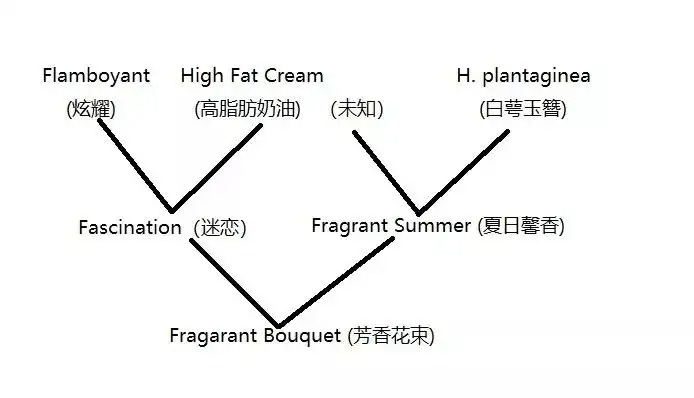
Hybrid parent diagram
'Fragrant Bouquet' itself is a super hybrid, the product of more than three generations of hybridization. Its fragrance primarily comes from its parent plant, the southern native 'White-calyx Hosta' (H. plantaginea). This was the earliest hosta to enter Europe and the only native species with fragrant flowers in nature. It blooms in the afternoon, with the fragrance becoming more pronounced in the evening. Its flowers are twice as large as those of most native hosta species and are well-adapted to the humid and hot southern climate. Another advantage is that it produces leaves continuously from spring to summer, unlike other hostas, which only produce leaves once in spring. However, it also has significant drawbacks, such as its flabby leaves, which are easily eaten by slugs, and its relatively poor cold tolerance. Its leaves develop too early, killing the new leaves in late spring cold snaps.
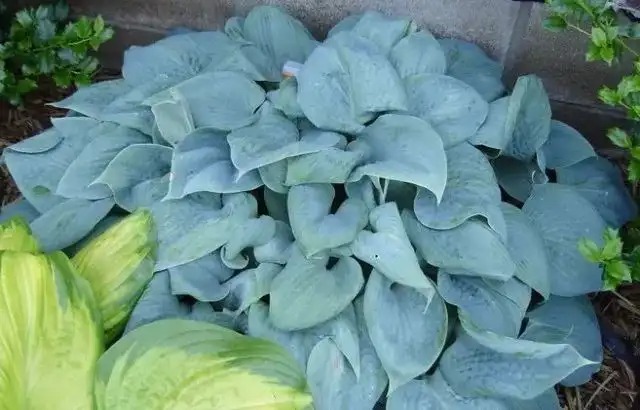
Fragrant Blue 'Fragrant Blue'
There's still much room for improvement in the field of fragrant hostas. Breeders have long sought to develop a blue fragrant hosta, capturing the best characteristics of both 'White-calyx Hosta' (H. plantaginea) and 'Round-leaved Hosta' (H. siebodliana). This goal is somewhat challenging, primarily because blue hostas typically bloom in May, while white hostas bloom until August. Furthermore, blue hostas typically bloom in the morning, while white hostas typically bloom in the afternoon, around 4 or 5 p.m. Therefore, it takes some effort to ensure cross-pollination between the two species. 'Fragrant Blue' is a cultivar developed with this goal in mind, but its fragrance is very faint, not as pronounced as in the 'Fragrant Bouquet' series.
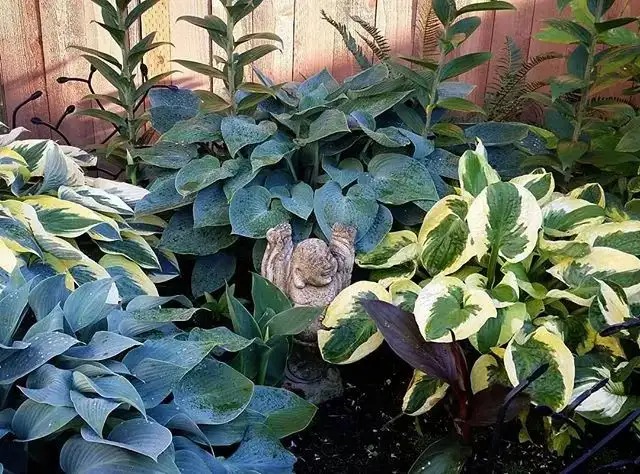
The main horticultural market is in the south, and the hybrid line with white-calyx hosta as the parent should be the most promising, but it is also the most easily overlooked by foreign breeders.
blue
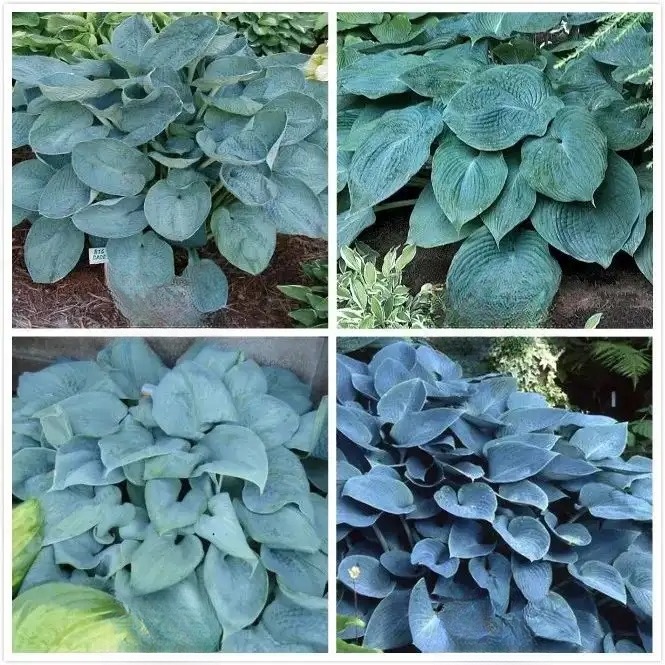
Common blue hosta in China
In nature, blue variants of hosta exist in species including H. sieboldiana, H. kikutii, H. pychnophylla, H. nigrescens, and H. hypoleuca. However, the blue hostas currently available on the market are essentially descendants of H. sieboldiana. In the 1960s, British breeder Eric Smith crossed an ancient Japanese species, 'Tardiflora,' with a German hybrid of H. sieboldiana, 'Elegance.' He produced numerous blue offspring, later known as the 'Tadiana group.' Among these, 'Halcyon' is the most famous, widely used as a parent in hybridization and a landmark in the rise of blue hosta.
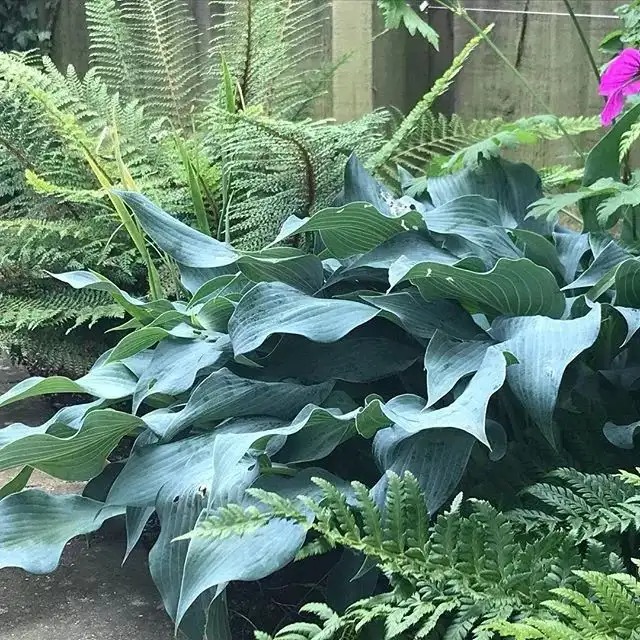
Since the 1980s and 1990s in the United States, blue hostas have become widely used in landscaping projects. Large blue hostas are currently the best-sellers in the US market. However, in China, blue hostas only perform well in northern China, with average performance in Jiangsu, Zhejiang, and Shanghai. Hostas' blue color actually comes from a waxy layer. As the weather in the south warms, this waxy layer dissolves and disappears, and rain also partially dissolves it, turning the color green. Since most blue hostas only produce leaves in spring, once they turn green, they won't turn blue again that year, forcing them to wait until the following year for new leaves to appear. 'Fragrant Blue', because it inherits genes from the white-calyx hosta (H. plantaginea), continues to produce new leaves, allowing the blue color to persist longer. Overall, it's a blue variety well-suited to southern climates.
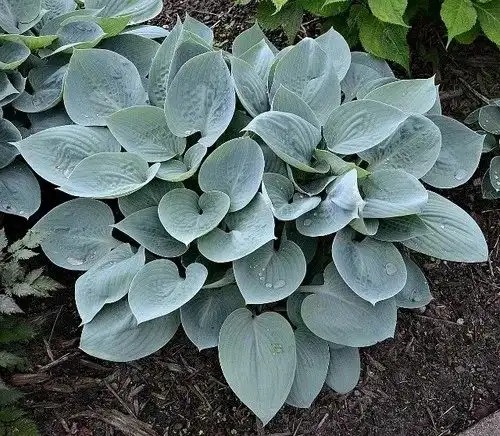
'Prairie Sky'
Very suitable for the hot and humid weather in the south, the blue variety lasts two to three months longer than the ordinary variety
There are now more and more improved blue varieties. These are either tetraploid varieties with two layers of wax, which allows the blue color to last longer, or they secrete wax multiple times at different stages of growth, allowing them to turn blue again even after being sunburned. Generally speaking, the larger the plant, the more blue wax it secretes, and the deeper the blue. Young seedlings only reach their peak display after four or five years.
White
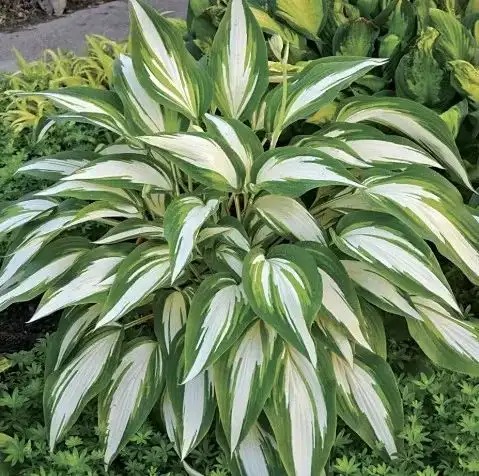
Cool as a Cucumber
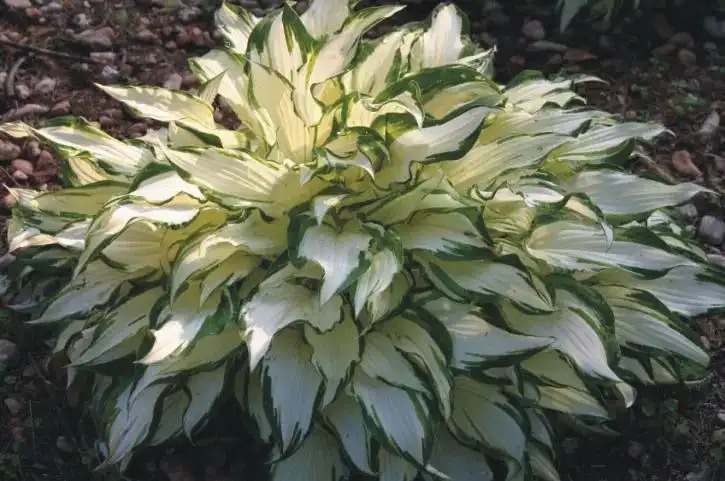
White Christmas
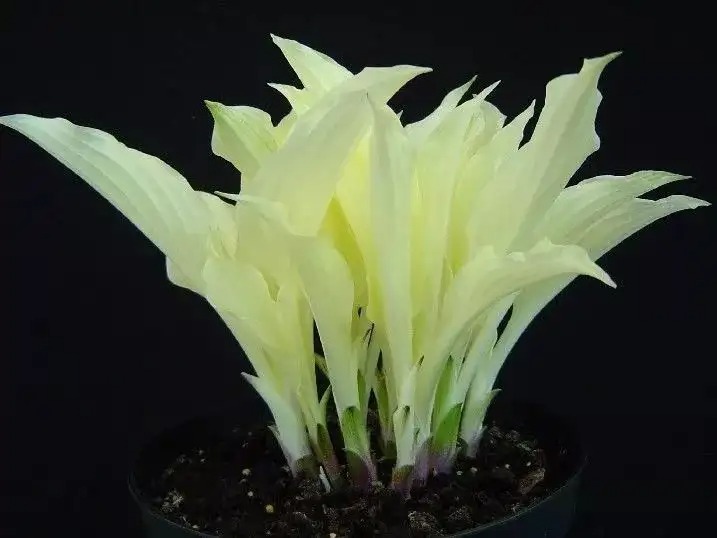
White Feather 'Shirabane'
The three white hostas above have progressively larger white areas. Varieties with more white are more difficult to grow and require more environmentally friendly environments. Because plants require chlorophyll for photosynthesis, pure white hostas don't exist in nature. They can be white with green patches, such as 'Cool as a Cucumber' and 'White Christmax'; or they can be white when they first sprout and then turn green, such as the currently popular 'White Feather'.
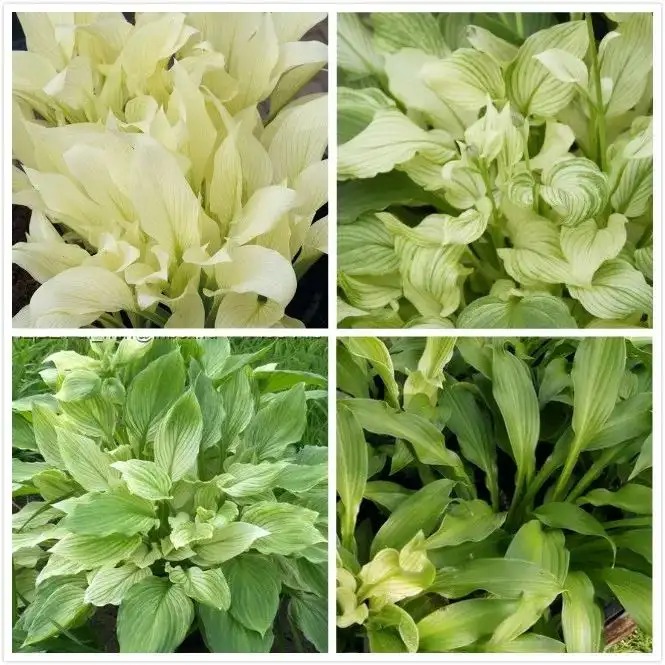
'White Feather' leaf color change process
'White Feather' was discovered by the Dutch and is a mutant of an older variety called 'Undulata'. It grows slowly, its white coloration lasts only briefly, it's very sensitive to sunlight, and is easily eaten by slugs. While it's a poor choice for a garden plant, it's well worth acquiring for plant lovers.

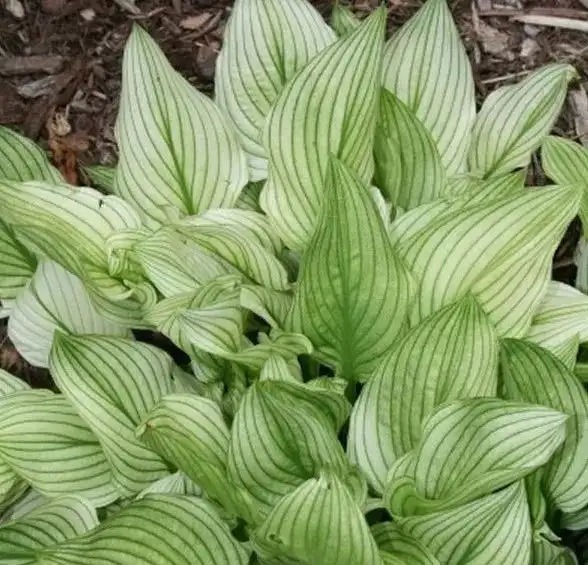
Zebra Stripes 'Zebra Stripes'
Tony Avent of the United States created a hybrid white hosta cultivar called 'Zebra Stripes.' 'Zebra Stripes' is similar to 'White Feather.' Its new leaves are also white, but with distinct green veins. It grows more vigorously. 'Zebra Stripes' also shares one-eighth of its genes with the ancient species 'Undulata,' so perhaps a gene in this ancient species is responsible for the white mutation in its offspring.
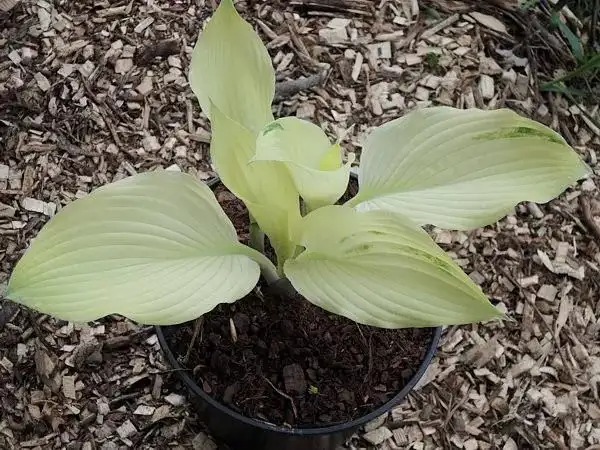
Spring Ghost
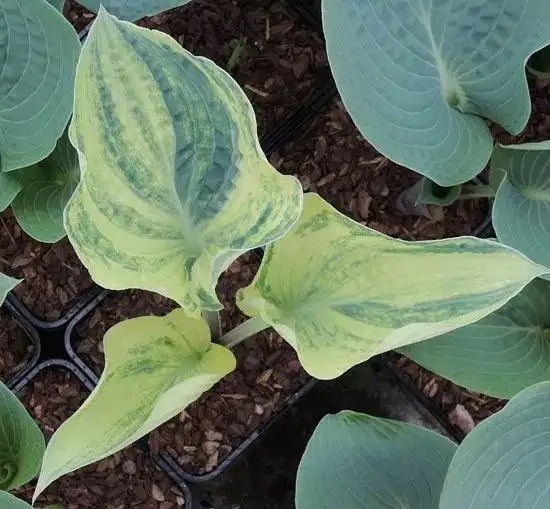
'Spring Ghost' has white new leaves, which gradually turn yellow and develop blue-green stripes.
In 2006, Danny Van Eechaute of Belgium released a white hosta called 'Spring Ghost,' currently the most resilient and fastest-growing variety of its type. In fact, 'White Feather,' 'Zebra Stripes,' and 'Spring Ghost' are genetically distinct; they share a common condition called "genetic short-term albinism," making them considered companions. 'Spring Ghost' has a high proportion of genes from the round-leaved hosta, resulting in thick leaves and robust growth, making it relatively resilient even when diseased. Unfortunately, this variety suffers from a low replication rate in tissue culture, making it difficult to mass-produce.
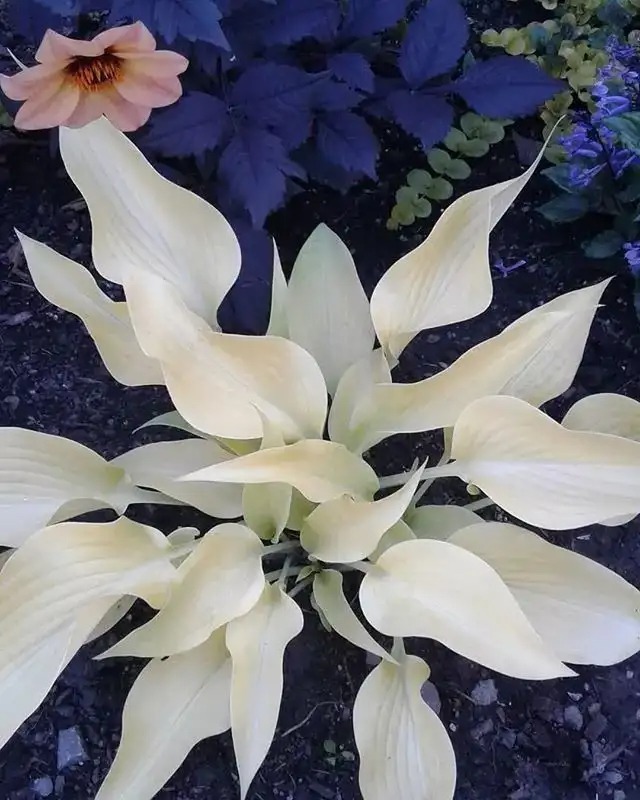
It's beautiful, but...
Even if white hostas are improved, they can't compare to regular hostas because the white part can't photosynthesize, and without food, they definitely won't grow much. Dear, don't be obsessed...
red
If someone asks you where you can find red-leaved hostas, you will definitely answer: Suqian. But now there really are red-leaved hostas, although they are not so beautiful.
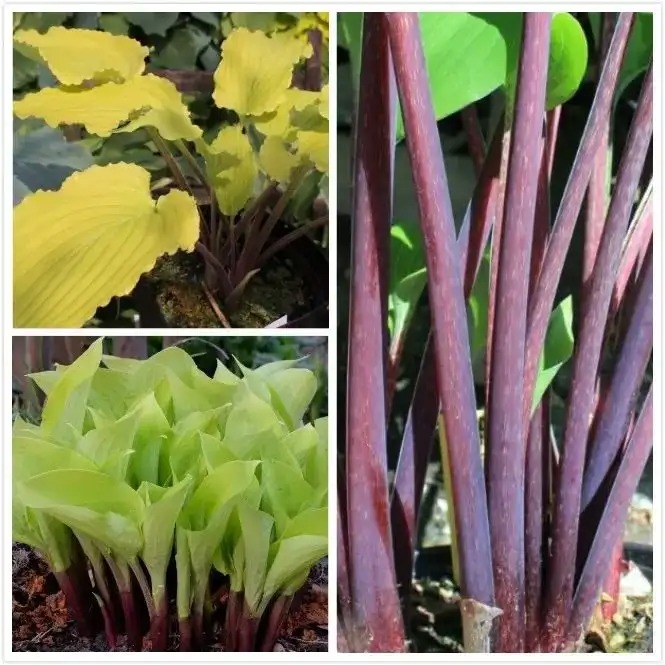
Red petiole variety
Some hosta species in nature, such as H. longipes and H. pycnophylla, have dark red petioles. Targeted breeding has made this trait more prominent, resulting in many varieties with dark red petioles.
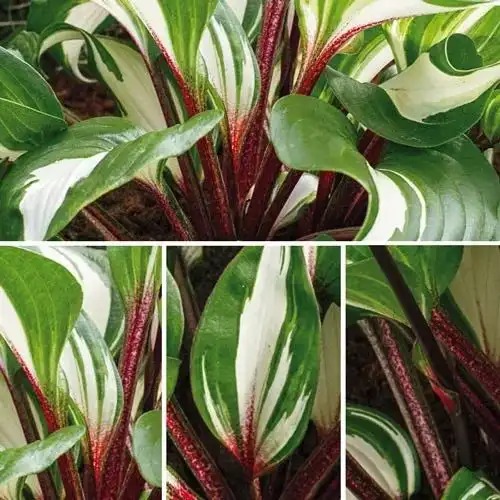
Raspberry Sundae
Later, during hybridization, it was discovered that dark red spots appeared at the junction of the red petiole and the leaf blade of some varieties. This means that the red color of the petiole can spread to the leaf surface.

First Blush
Bob Solberg of North Carolina, USA, hybridized a red-petioled variety with a new hybrid, creating the groundbreaking cultivar 'First Blush.' Its new leaves are green, but when it leaves a second time, the older leaves turn rust-red. After being registered in 2016, it has become a sought-after hosta collector. While it's not a perfect variety, and its ornamental value is only average, it represents a significant breakthrough in breeding and is poised to usher in a new era.
Variegated leaves
Compared to most plants, hostas are an anomaly. The distribution of chromatin on their leaves is highly erratic, changing color at the drop of a hat. So if your hosta suddenly sprouts a different leaf, don't be alarmed or surprised; this is just normal. However, despite these changes, they can generally be categorized into a few types.
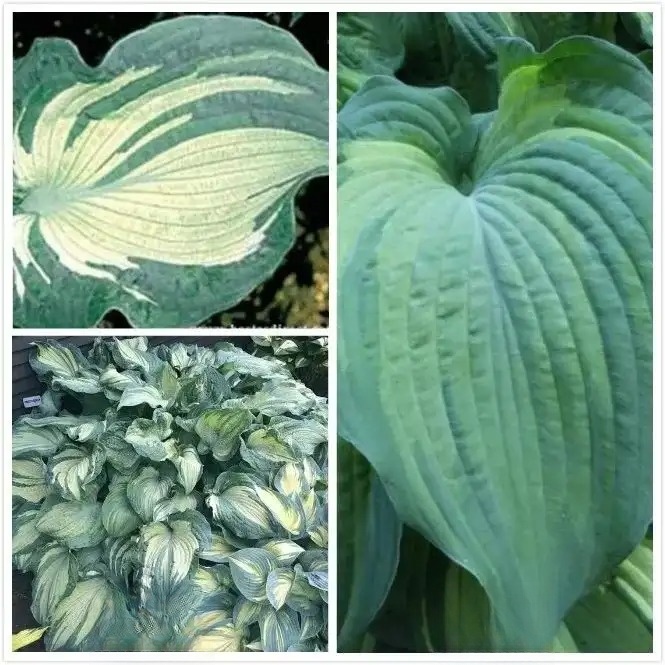
Guardian Angel
The first type is the green variant , such as 'Guardian Angel', which has a yellow-white center area when it is a new leaf and then turns green.

Rainforest Sunrise Rainforest Sunrise
Hosta Varieties of 2013
The second type is the yellow variant . For example, the new leaves of 'Rainforest Sunrise' are typically green in the center, then turn yellow. If the variant covers the entire leaf, it becomes a single-color golden leaf variety.
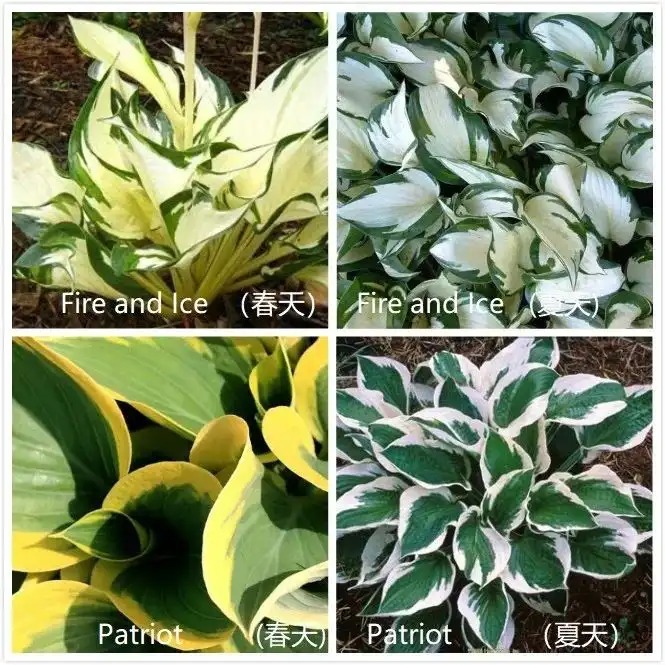
The third category is the white variant , whose leaves are typically yellow when new and then turn white. Varieties like 'Patriot' and 'Fire and Ice' fall into this category. Interestingly, 'Fire and Ice' is a variant of 'Patriot'. 'Patriot' has spots on the edges, while 'Fire and Ice' has spots in the center, a perfect offset. White leaves are generally thinner and more susceptible to sunburn.
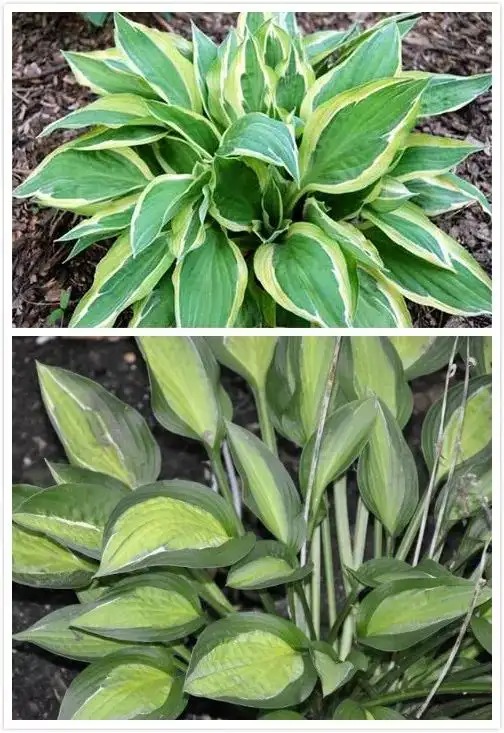
Hanky Panky
The leaf color is changeable and the pattern is unique, but it is unstable and requires continuous division to keep the pattern unchanged.
Some varieties combine two morphs, such as 'Qingqingwowo'. Its edges are a green morph, changing from yellow to green, while its center is a yellow morph, changing from green to yellow. This will be a very interesting breeding direction. Furthermore, the new variegated varieties are already breaking through the conventional color combinations we see, and there will undoubtedly be more interesting new varieties in the future.
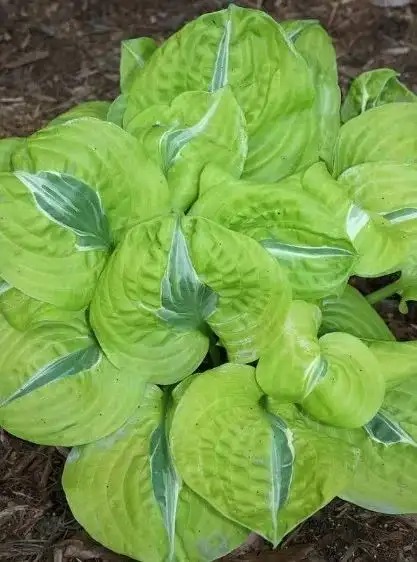
Time Traveler
The flower color is very strange, it grows slowly, and a tiny seedling costs $100.
Variegated hostas are not very useful for breeding because their markings are not inherited, and their offspring are generally solid color, matching the center color of the variegated hosta. So how did the common variegated hosta come about? One source is a mutant of a solid color variety, and another is a hybridization or mutation of a striped hosta.
Striped Hosta
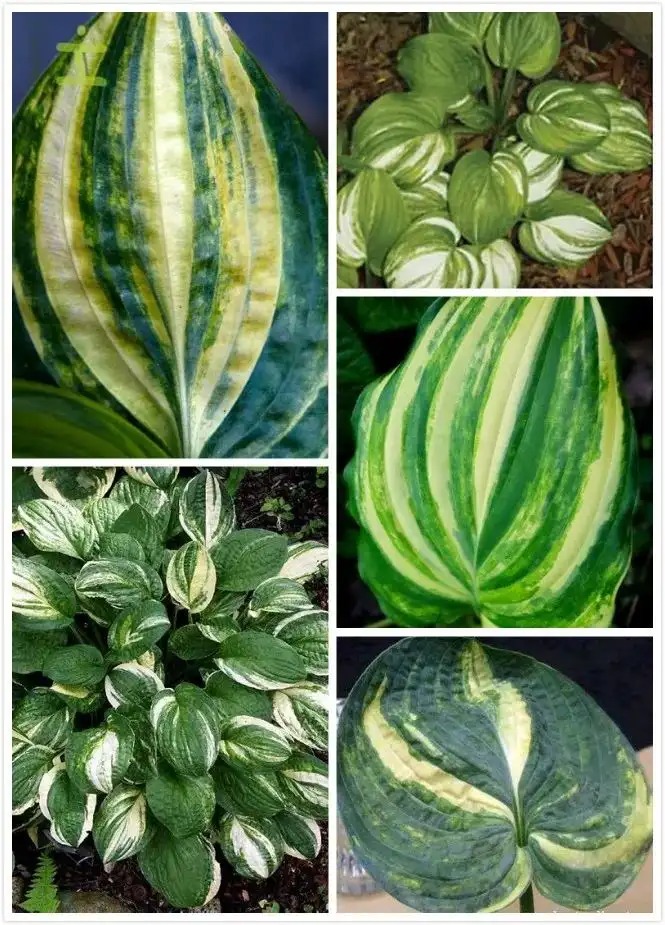
Striped Hosta
Striped Hosta is a type of Hosta that is rarely seen in China and is a must-have for breeders. Unlike ordinary variegated Hosta, the striped Hosta's pattern is not fixed in the center or edge area, but is random, and each leaf is different.
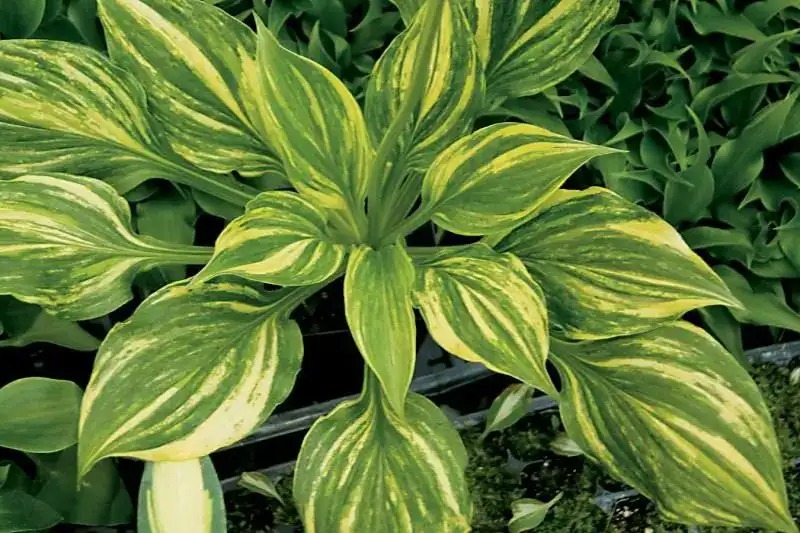
Striped Hosta Kaleidochrome

Kaleidochrome's seed-bearing descendants
Striped hosta is very unstable, and during tissue culture production, most individuals will mutate, resulting in a high probability of mismatch and preventing mass production. This instability also makes striped hosta an excellent hybrid parent, with a certain percentage of offspring displaying a rich variety of markings.
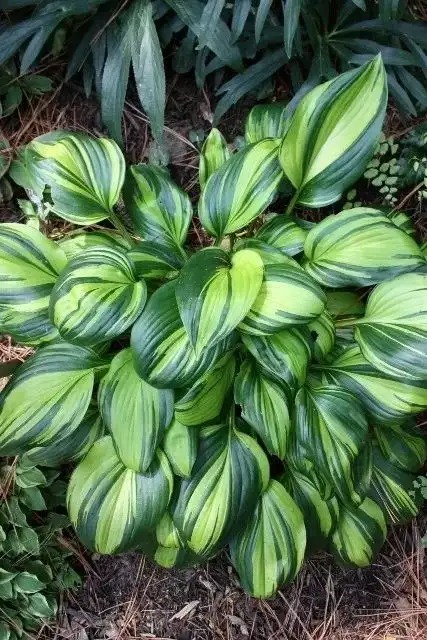
'Rainbow's End'
A popular, slow-growing striped variety with thick, glossy, dark green leaves.
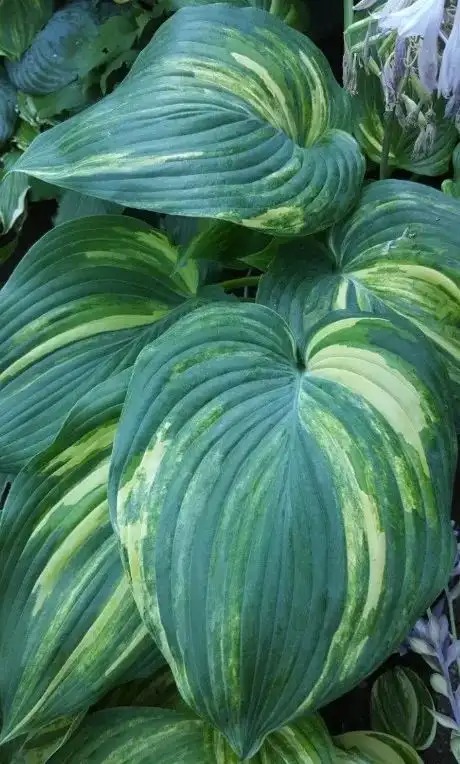
'Valley's Super Tuesday'
The striped variant of 'Elegant' and 'Wu Zetian' are a cross, beautiful like a piece of printed cloth with a blue background.
Most striped hostas continue to mutate until they stabilize. So, after several years, most of the patches settle into the center or edges, resembling a regular variegated hosta. In the 1970s, a striped cultivar called 'High Fat Cream' was widely used in hybrids (it appears in the parent image of 'Scented Bouquet' mentioned above), but this cultivar is now largely lost, having mutated and disappeared. On the other hand, regular cultivars can mutate into striped forms, as seen in the 'Striped Gold Label' mutant shown below.

Gold Standard
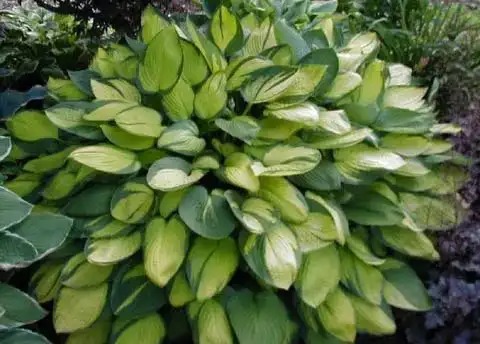
Streaked Gold Standard
Because tissue culture has a very low match rate, striped hostas can only be propagated by root division. Many varieties are often sold out abroad and are expensive. However, if you are breeding, striped hostas are a must-buy.
Cup type
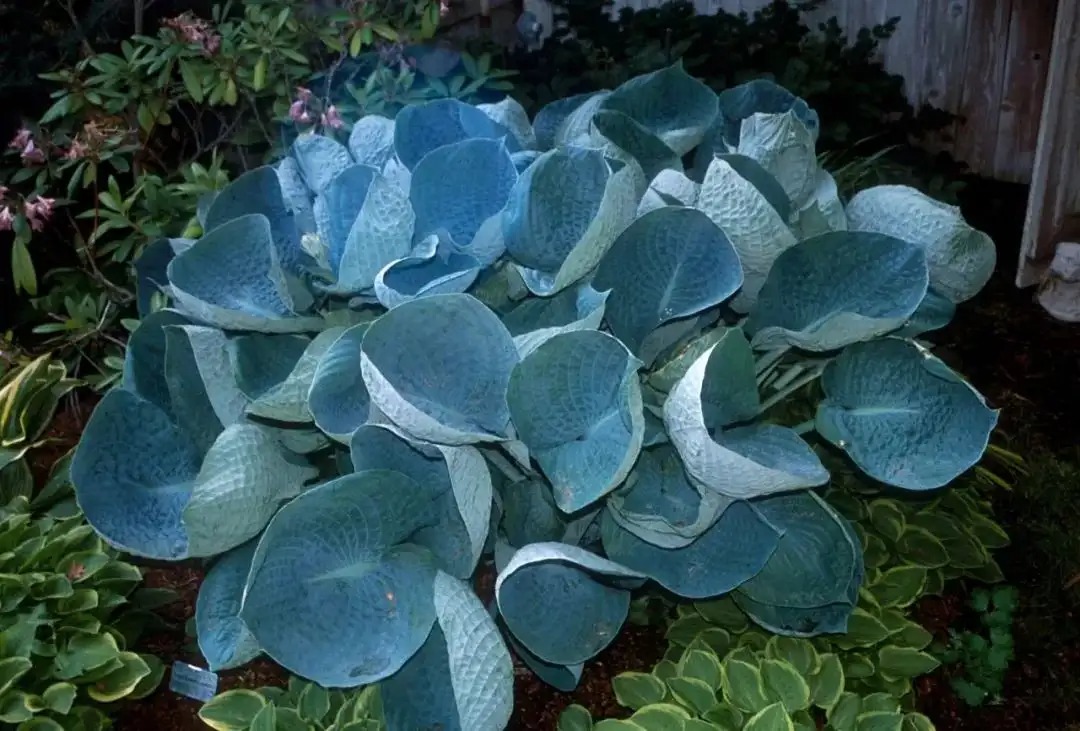
'Abiqua Drinking Gourd'
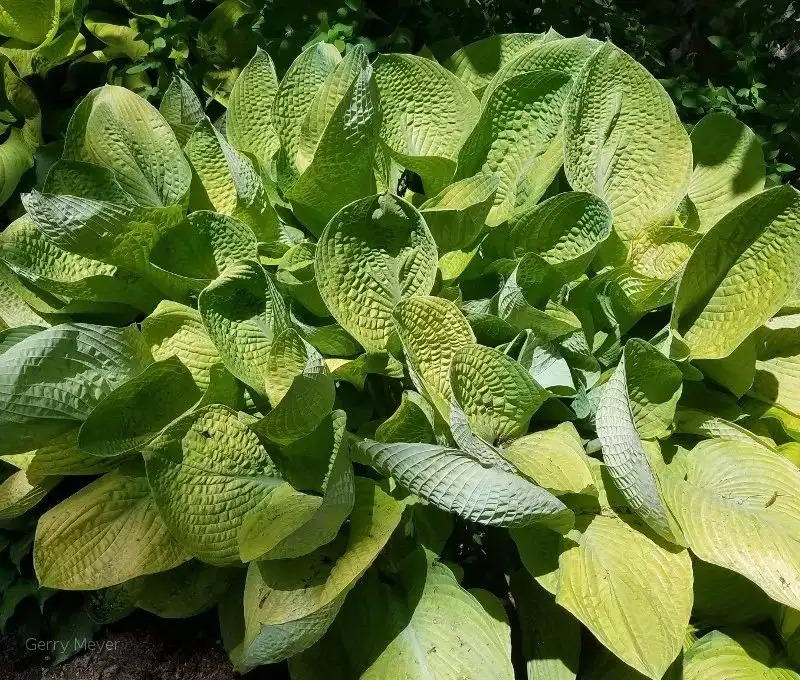
World Cup
The 2014 and 2018 Hosta Plant of the Year were 'Abiqua Drinking Gourd' and 'World Cup,' respectively. These two cultivars are distinguished by their cup-shaped leaves and seersucker-like wrinkles. This cup-shaped leaf pattern is largely derived from the genes of an ancient Japanese cultivar, 'Tokudama.'
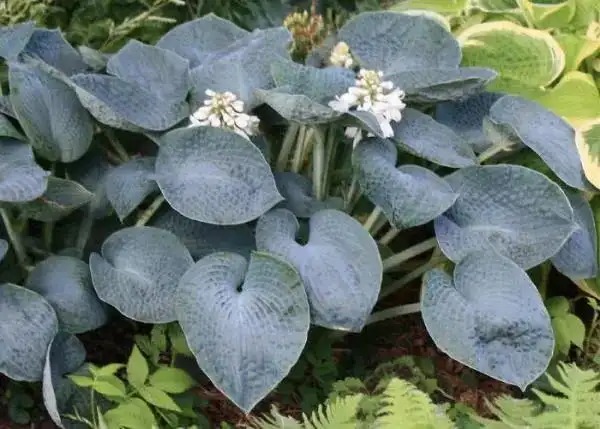
Tokudama
'Tokudama' resembles a miniature round-leaved hosta, with thick, deeply wrinkled blue leaves that curl slightly like a cup. This slow-growing variety wasn't widely adopted after being brought back to England by plant hunters around 1800. However, a breeder selectively selected it, enhancing its cup-shaped leaves and creating a unique cup-shaped variety. The origin of 'Tokudama' is unknown, but I personally believe it's a variant of the round-leaved hosta. Regardless of its botanical species, its function in hybridization is independent of that species.
Upright
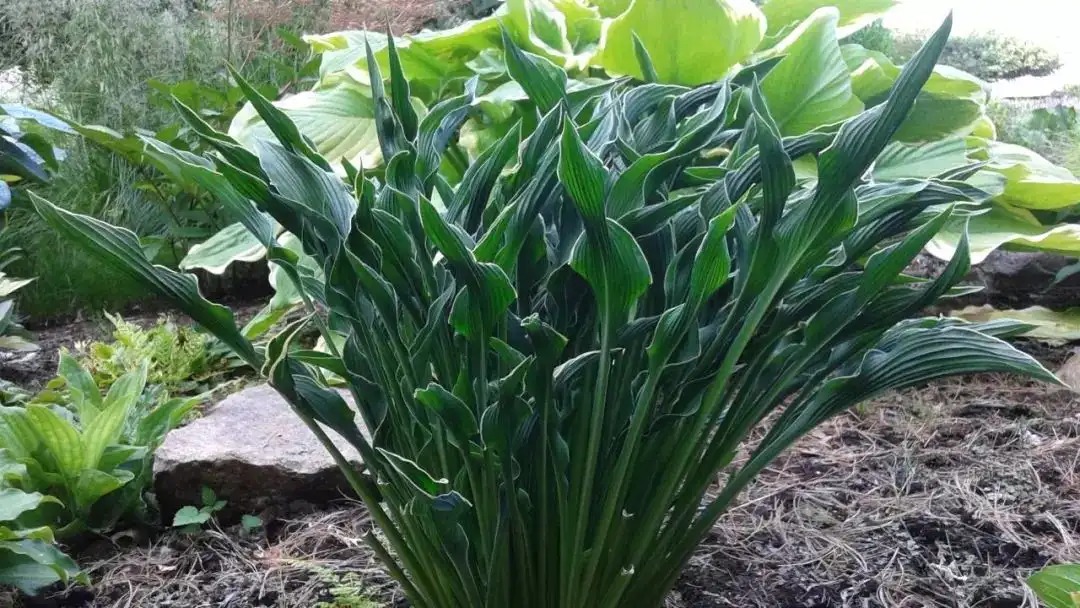
Praying Hands
If I had to choose a single, most recognizable hosta variety, I'd guess ' Praying Hands' would be in the top three. Its leaves curl deeply inward and stand upright, unlike any other variety. Its origins are also unclear. Because the name 'Praying Hands' has obvious religious connotations, and according to the First Amendment to the U.S. Constitution , which prohibits an establishment of religion or abridgment of religious freedom, this variety is not permitted near the Alabama state capitol.

Hands Up
Logically, this variety could be used for hybridization to create a new line of upright hosta. Unfortunately, 'Praying Hands' is sterile, a common problem with many mutant varieties. Despite their outstanding traits, they cannot be used in further hybridization. However, during tissue culture, a tetraploid emerged from this variety. 'Hands Up' is an accidental tetraploid of 'Praying Hands'. While tetraploids are typically taller than diploids, the 'Hands Up' tetraploid was smaller.
Long leaf type

Common hostas have oval or heart-shaped leaves, but the leaves above are very narrow and long, and some have curled edges. The gene for this narrow leaf comes from Hosta sieboldii.
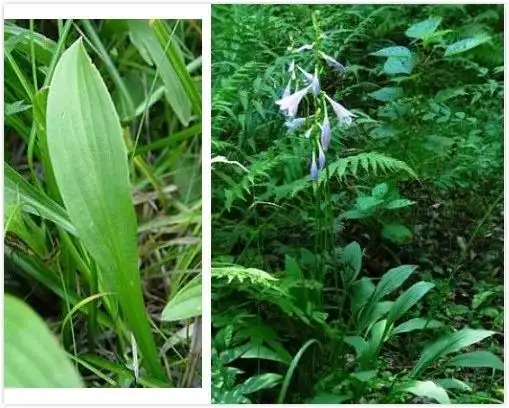
Hosta sieboldii
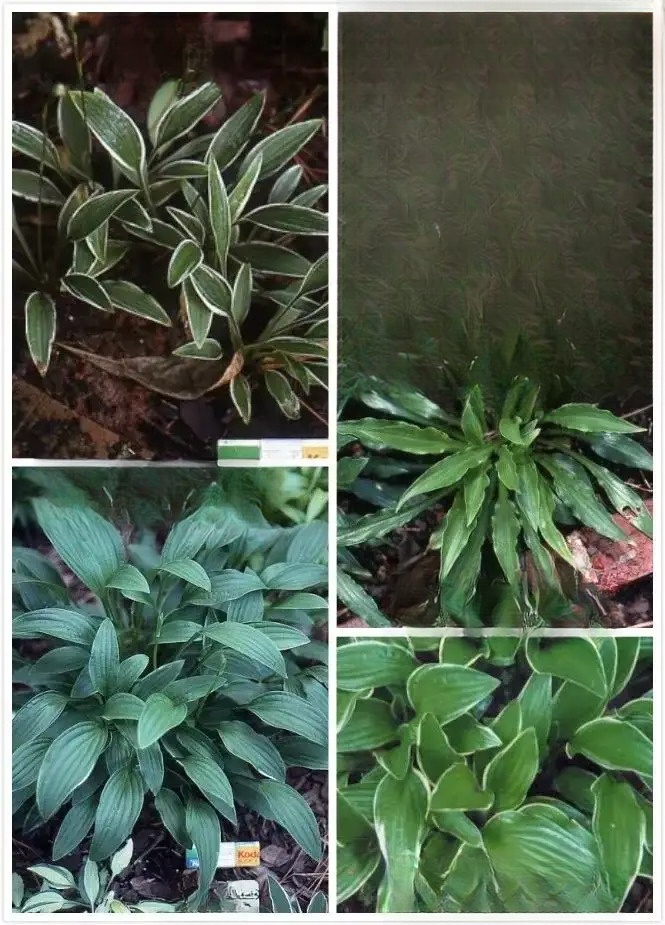
Variations of Hosta microphylla
The original Hosta microphylla is rarely used in hybridization. Instead, its variants have become important parents of modern Hosta. Hosta microphylla is a very robust plant in its native habitat, able to dominate weeds and produce large quantities of seeds. However, its shortcomings are also significant: slow growth, difficulty in dividing, and a tendency to dormant in hot summers. Many breeders believe that this species has been overused in hybridization, resulting in its many shortcomings being reflected in many varieties.

Hosta Longissima var. longifolia Long-leafed hosta
In fact, longleaf hosta and smooth hosta (H. laevigata) have narrower and longer leaves than smallleaf hosta, but these two species are not as widely used in modern hosta hybrids as smallleaf hosta. This is either due to their late flowering period or low seed set. For example, longleaf hosta blooms from mid-September to October, while the seeds of other species have already germinated and grown true leaves, while this species has not yet bloomed, making it difficult to manage. However, longleaf hosta is uniquely resistant to moisture and can be grown in swamps, so it should be more widely cultivated.
Water droplet wave shape

Hybrid offspring of dense-leaved hosta
These varieties all come from the Valley Hosta nursery in Zwolle, the Netherlands.
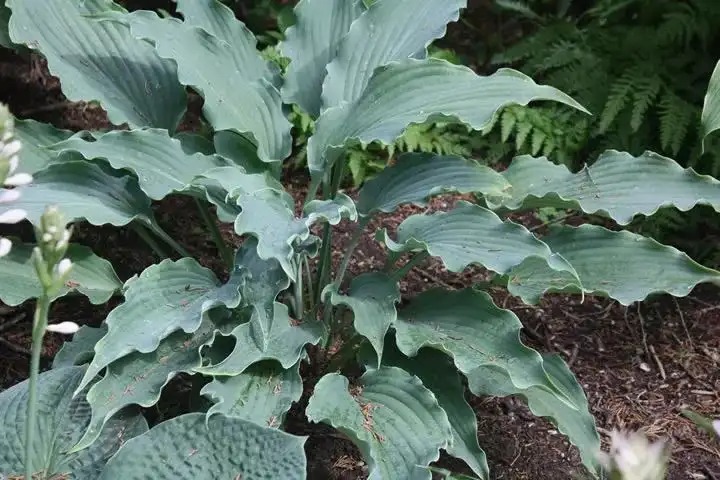
Neptune (a hybrid of white-backed Hosta)
This type of hosta is relatively rare in China, though some can be found in imported bare-root seedlings. The wavy edge gene primarily comes from Hosta pycnophylla and Hosta hypoleuca. These two species are extremely similar, with elongated teardrop-like leaf shapes and wavy edges ( more pronounced in Hosta pycnophylla) and a pinkish-white underside (more pronounced in Hosta hypoleuca), making them highly recognizable. Both species have a relatively limited distribution range and are not particularly easy to cultivate, but in recent years they have been recognized as highly useful parental lines and widely used in hybridization.
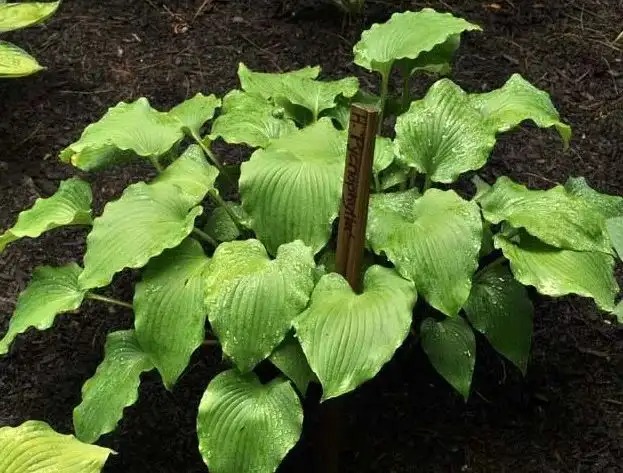
Hosta pycnophylla
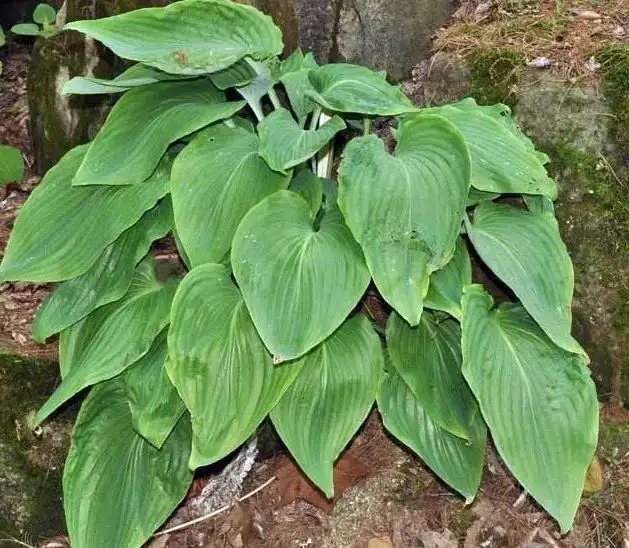
Hosta hypoleuca
Not all wavy-edge plants are descendants of these two species, but most of the descendants of white-backed hosta and dense-leaved hosta also inherit the long teardrop-shaped leaves, so it is relatively easy to see.
Unique flower shape

Miracle Lemony
For a long time, hostas were thought to come in only white and varying shades of purple (or blue) until a cultivar called 'Miracle Lemon' was introduced to the West from Japan. This cultivar, reputedly a descendant of a newly discovered species, Hosta tusuhimensis, boasts pale yellow flowers and a fragrant aroma. Despite its unattractive foliage and overall horticultural performance, it fetched high prices upon its release. This cultivar has now been tissue-cultured in the Netherlands, and bare-root seedlings have been seen in China. Whether they match the original is another matter, as the Dutch bare-root seedlings have a high error rate.
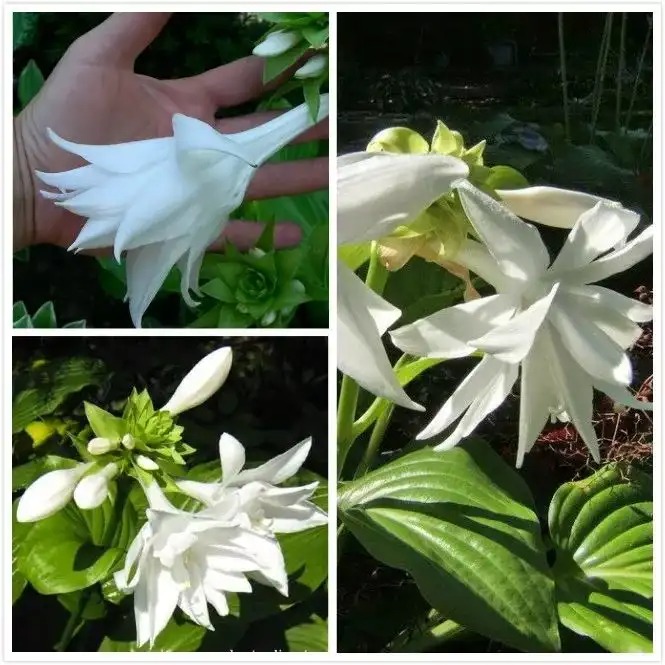
Venus
Some original species have previously garnered special attention from breeders due to their unique flower forms. For example, the two double-petaled variants of the white-calyx hosta (H. plantaginea), 'Aphrodite' and 'Venus', have consistently been among the top flower-viewing varieties. White-calyx hosta flowers are naturally much larger than those of standard hostas, and these two variants boast even larger flowers, with up to 24 petals. However, both varieties require exceptionally long periods of warm weather to bloom. Many North American hosta enthusiasts report being filled with anticipation every time they see the buds swell, only to have the weather turn cold before they open, leaving the buds, which have lingered for weeks, to fall into the soil and turn into mud. All I can say is that even in Jiangsu, Zhejiang, and Shanghai, there are things you wouldn't envy! Furthermore, the goddess of beauty in Roman mythology was called 'Venus,' and in Greek mythology, 'Aphrodite,' making these names seem like a double act.

Hosta Capitata
Hosta capitis (H. capitals) is another species with beautiful flowers, or more accurately, beautiful buds. Its buds hang on the stalks for a long time, creating a lovely rounded appearance. However, it is not widely used in hybrids.

Generally, the flowers of hosta point in one direction.

Hosta yingerii
Yingerii and leavigata are two closely related species native to Korea. Their most distinctive feature is their evenly distributed flowers, unlike most hostas, which tend to cluster and point in one direction. H. yingerii, in particular, has a high seed-setting rate. Despite its recent discovery, it has been extensively used in hosta hybridization over the past decade.
other

The above briefly summarizes the more distinctive varieties and their genetic origins. Due to space limitations (and my real dislike for being obsessed with hostas), I cannot introduce all the original species and their descendants. Some original species were discovered too late for hybridization; some had more flaws than advantages, making breeders reluctant to use them as parents; or some were used in hybridization, but the offspring did not produce particularly good varieties. For example, the purple-calyx hosta (Hosta ventricosa), native to Taiwan , is the only tetraploid among the original species. It reproduces asexually and cannot serve as the mother parent in hybridization, only as the father. Furthermore, this species has very thin leaves, which are prone to scorching in southern China. Hybridization using it as a parent has not produced particularly good offspring. With such a vast territory, there must be abundant natural variation in the wild, all of which could potentially serve as optimal hybrid parents.
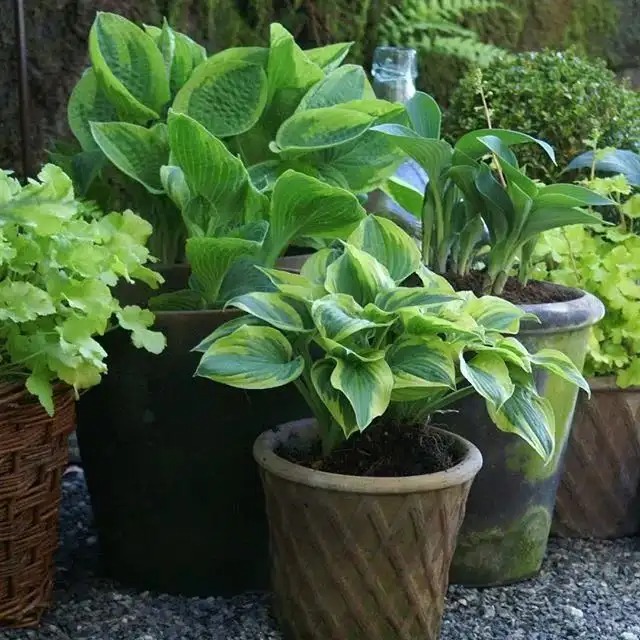
Planting hostas in pots of different heights can add a sense of layering
Most hosta varieties sold on the market are tissue-cultured, with few vendors using root division for propagation. Most of these tissue-cultured varieties are historical American annuals, including 'Francee' and 'Patriot,' which were popular in landscaping projects in the 1980s and 1990s. These varieties have stood the test of time. However, the primary growing zone in the United States is zones 5-8, making them less than optimal for Jiangsu, Zhejiang, and Shanghai. Furthermore, tissue-cultured varieties in China are limited in variety, mostly descendants of Hosta rotundifolia, Hosta nigra, and Hosta 'Fortunei,' requiring similar growing conditions. For example, 'Elegans,' 'June,' 'Halcyon,' 'First Frost,' 'Frances Williams,' 'Big Daddy,' 'American Halo,' 'Rainforest Sunrise,' 'Great Expectation,' and so on are all hybrid varieties of round-leaved hosta. They share the advantages of vigorous growth and resistance to slugs, but their optimal growing conditions are cool, humid areas with low sunlight. They are not drought-tolerant, limiting their application range. In contrast, imported bare-root hosta seedlings offer a wider selection. However, many sellers translate the names, making it difficult to guess the English variety names or find out their specific characteristics. I hope to list more varieties and their characteristics in the future to facilitate selection.
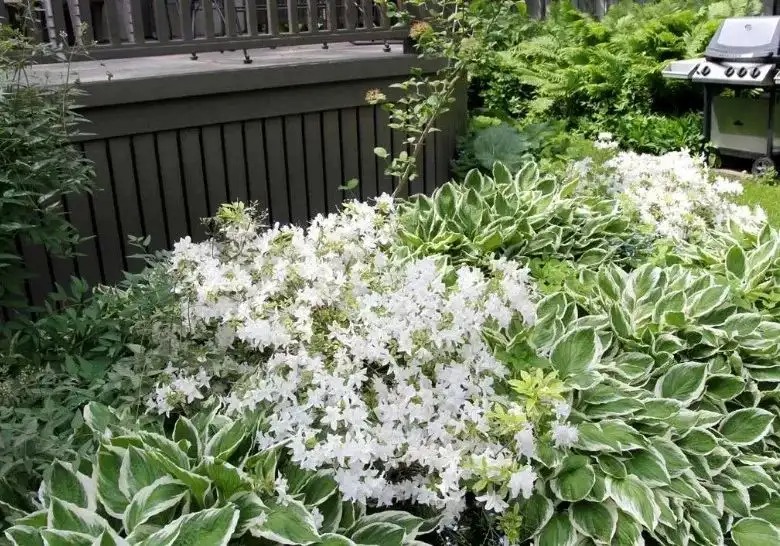
The root systems of some hostas are extremely developed and have the ability to strangle surrounding plants.
Do not plant it together with plants with underdeveloped root systems such as azaleas.